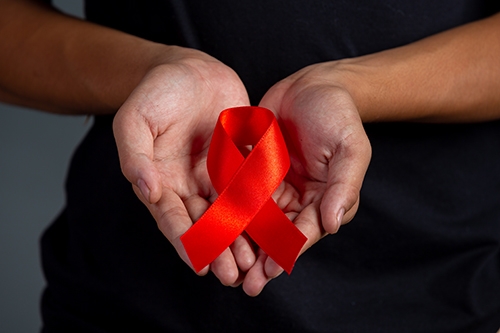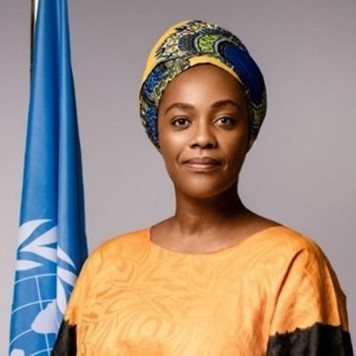

Eva Kiwango, South Africa’s country director for UNAIDS, addressed the MPhil students at the Africa Centre for HIV/Aids Management on the urgent need to address inequalities in order to get back on track with global HIV/Aids targets.
THE EYE of the recent Covid-19 storm lasted a mere two years. Yet, many people reached pandemic fatigue long before this, in different ways: finding loopholes in social restrictions, refusing to wear masks, or simply becoming detached from new statistics. With the HIV/Aids pandemic having been ongoing for decades, the risk of losing a sense of urgency is therefore substantial – and evident.
In mid-April, MPhil students at the Africa Centre for HIV/Aids Management had the privilege of gaining detailed insights on the critical numbers, gaps and required strategies from Eva Kiwango, South Africa’s country director for UNAIDS, at the “Master your master’s” workshop.
Significant progress, but from what baseline?
As with any thorough HIV/Aids coverage, Kiwango does not discount the vast progress made to date. This includes reductions in new infections (which have halved since 1996) and Aids-related deaths worldwide. Numbers can however be deceiving: “We missed the 2020 targets [the 1,5 million new infections in 2021 are way above the target of 500 000], and we now have only seven years to go until the 2030 goal to end Aids,” she pointed out, emphasising that the trends are not changing fast enough. The burden is especially heavy in Africa, which has 54% of all people living with HIV.
So how do we change the trajectory? Kiwango highlighted that it’s vital to look at the granular statistics to identify who is being left behind and why – we can’t rely on absolute data to identify problems. “The role of community-based organisations has become crucial, putting people at the centre,” she said. This focus is reflected in current targets including societal enablers (e.g. limited access to HIV services, discrimination and gender-based violence) for the first time.
Inequality – the great obstacle
Once one starts looking at the data on a more granular level, the biggest obstacle to progressing towards HIV/Aids targets quickly becomes clear: inequality. Kiwango mentioned two of the most effective tools in preventing new infections – condoms and pre-exposure prophylaxis (PrEP). While increased condom use has prevented an estimated 117 million infections over the past 30 years, access and use are still marred by inequalities, with condom use by uneducated men at much lower levels. Gaps in PrEP provision and uptake tell a similar story, with affordability a key challenge.
From a gender inequality viewpoint, the vulnerability of women and girls remains a concern, and the statistics are alarming: in 2021, there was a new HIV infection among adolescent girls and young women (between 15 and 24 years) in sub-Saharan Africa every two minutes. HIV prevalence in key populations further highlights inequalities in access to sexual health, reproductive and HIV services. These populations include sex workers, people who inject drugs, gay men and other men who have sex with men as well as transgender women. “The criminalisation of key populations emphasises the need to address issues of discriminatory and punitive laws,” Kiwango said.
With a passion for children, Kiwango further highlighted that the system has been failing children affected by HIV. In 2021, about half of children living with HIV still did not have access to life-saving treatment. The lack of treatment as well as new infections among children (which are not declining sufficiently) are “simply unacceptable”. This is closely linked to unequal access to services for women – with maternal ART coverage being stagnant since 2015 – and new infections among pregnant or breastfeeding women.
Understanding these finer nuances of the statistics is invaluable to the MPhil students at the Africa Centre. “Our students are part of the next generation of Aids advocates who will determine the pandemic trajectory over the coming decade,” said Dr Munya Saruchera, interim director at the centre. “It is not every day that we have the privilege of first-hand access to international authorities on HIV and Aids like UNAIDS, where students could tap into Ms Kiwango’s expertise by engaging about specific challenges they face in their field of work.”
Funding imbalance aggravates the problem
The issue of inequality is also visible in funding gaps, some of which link back to population inequalities. A few years ago, for example, funding for programmes that benefit women and adolescent girls was less than 40% of the required amount. The funding gap also affects the neutral, health-related aspects of the pandemic, such as funding for TB treatment. While tuberculosis remains the leading cause of death among people living with HIV/Aids, Kiwango pointed out that less than half of people living with HIV and TB are receiving treatment for both conditions.
A recent Economist Impact report showed that a fully funded HIV/Aids response in Africa will deliver a triple dividend of health, social and economic gains. “It will contribute to human capital development, strengthen health systems and reduce new infections,” Kiwango said.
While tremendous progress has been made in the fight against this pandemic, the pace of progress has been too slow. Access to prevention services and treatment is not hitting the mark, and policy implementation is also lacking. A new approach is required. And it’s all in the granular details, as Kiwango said: “We must tailor our responses to the different needs of different populations if we want to beat this pandemic.”
Snapshot of the HIV/Aids pandemic status quo
Global targets
New HIV infections in 2021
- Number of new infections per day: 4 000
- 58% of these infections occurred in sub-Saharan Africa
- 10% of these were among children younger than 15
Spotlight on women
(aged 15 to 49)
- Aids-related causes remain the third highest cause of death globally for women
- In sub-Saharan Africa women accounted for 63% of new HIV infections in 2021
- Globally, 13% of women who’ve ever been married or had a partner have experienced physical and/or sexual violence by an intimate partner
HIV infection risk of specific groups
- Gay men and other men who have sex with men: 25 x greater risk than heterosexual men
- Female sex workers: 26 x greater risk than women in the general population
- Transgender women: 34 x greater risk than other adults
Source: UNAIDS
Other expert input at the MPhil workshop
The “Master your master’s” workshop featured a host of expert guest speakers, academics and students who presented and discussed recent developments, topics, challenges and goals in the world of HIV and Aids and about generating quality research.
The world of HIV and Aids
- HIV and Aids progress and challenges in Portuguese-speaking African countries (also known as PALOP) and West and Central Africa
- Inherent inequalities in the global health system and how to address these
- The importance of community-led monitoring in pandemic preparedness and improved primary healthcare
- Presentation of research topics by several MPhil students, covering socioeconomic aspects (e.g. access to mental healthcare, substance abuse), healthcare (e.g. factors affecting ART adherence and awareness of HIV prophylaxis) and legal (e.g. policies and legislation to promote female economic empowerment)
Conducting research
- The role of ethics in quality research
- Understanding the advantages and limitations of quantitative and quality research methods
- From concept to research proposal to structuring a research report
- How to use AI tools like ChatGPT ethically and responsibly in research
For more information about the Africa Centre’s academic programmes, click here or send an email to aidscentre@sun.ac.za or ralex@sun.ac.za.
